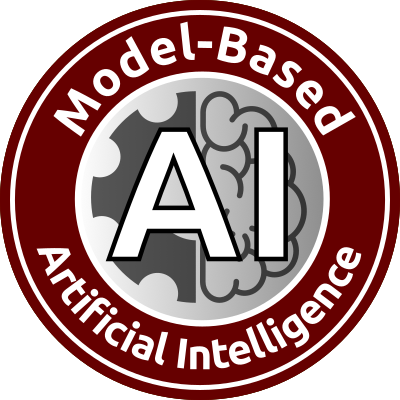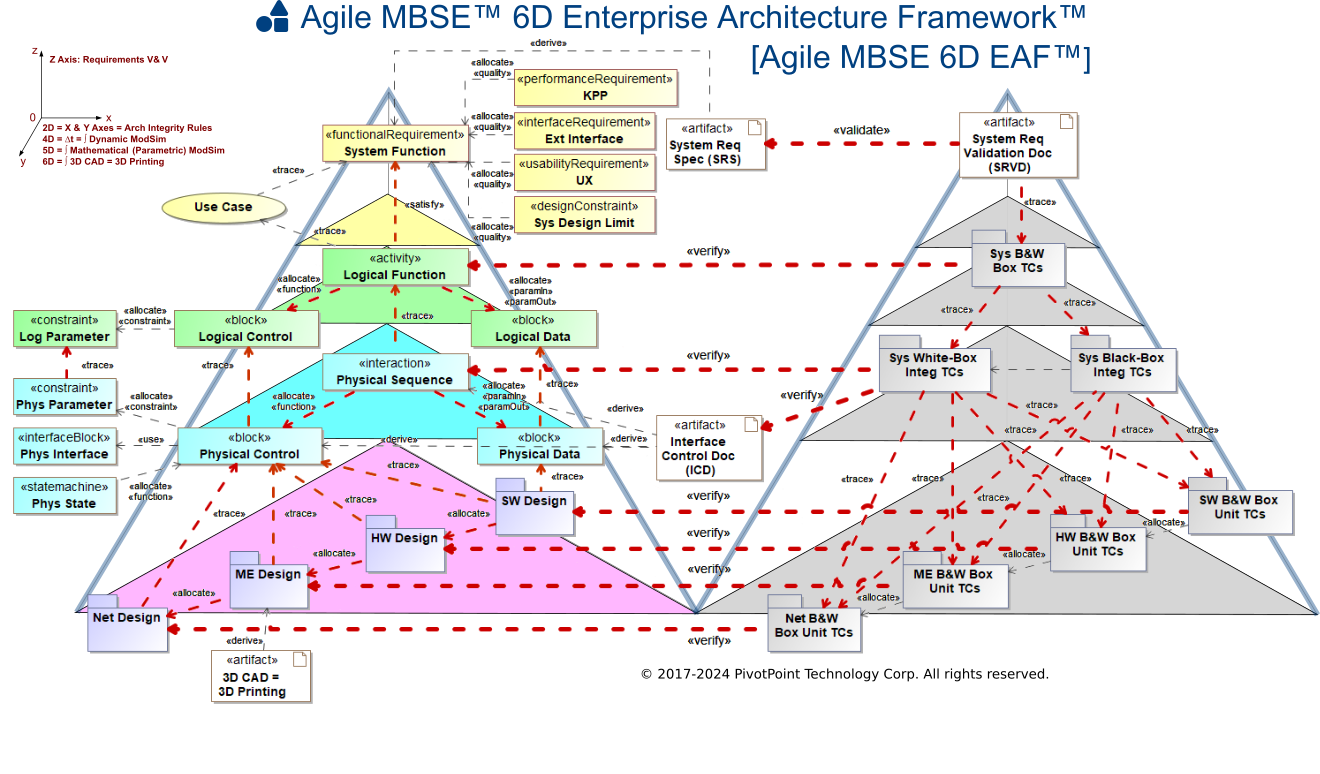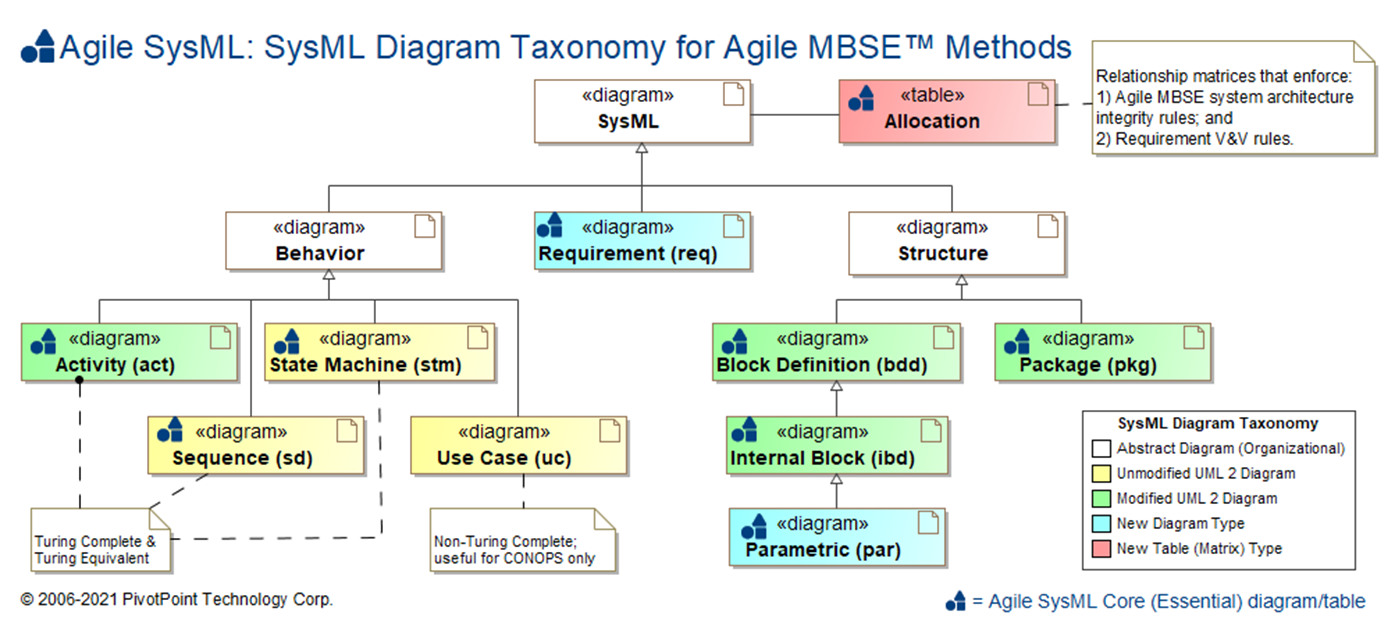SysML FAQ: What is Agile MBSE™?
What is Agile MBSE™ (Agile Model-Based Systems Engineering™)?
FAQ Variant(s): What is Agile Systems Engineering?
Agile MBSE™ = a hybrid Systems Engineering process that combines the strengths, and avoids the weaknesses, of "heavyweight" (a.k.a. "high ceremony", or "obese") Model-Based Systems Engineering (MBSE) processes and "lighweight" (a.k.a., "low ceremony" or "anorexic") Agile processes (e.g., Agile Software Development, Agile Engineering). The resultant "middleweight" Agile MBSE process is inherently more resilient (i.e., robust yet flexible) than either of its constituent processes, and consequently supports highly scaleable and simulatable system architectures.
As you might expect, a bona fide Agile MBSE Process requires a bona fide Agile SysML architecture modeling language to specify both MBSE work artifacts (e.g., System-of-System Architecture Model (SAM), Interface Control Docs) as well as itself (i.e., be self-descriptive). Towards that end PivotPoint has defined AgileML™ (Agile Modeling Language™), a "Lean" (as in Lean manufacturing and methods) subset of the OMG UML2/SysMLarchitecture modeling language standards that is extended for specifying scalable and simulatable Abile MBSE work artifacts.
Agile MBSE™ Process Features
It is essential that an Agile MBSE Process approach strives to meet or exceed the following goals:
Architecture-Centric Agile MBSE Process Features
- Architecture-centric: The Agile MBSE process must emphasize a precise and complete System-of-Systems Architecture Model (SSADM) as the primary work artifact throughout the System Development Life Cycle (SDLC). i.e., SAM = system architecture "truth" (cf. Agile Manifesto). The SSADM should be organized using an scalable and simulatable Architecture Framework (e.g., ISO/IEC 42010, DoDAF, TOGAF) pattern with multiple Views/Viewpoints;
- Support full SDLC with rigorous V&V: The Agile MBSE process must provide comprehensive support of all SDLC phases (Requirements, System Analysis, System Design, Implementation, System Integration &Testing);
- Requirements-driven: All System Analysis, System Design, and Implementation elements on the "Left Side" of the System V-Model must directly or indirectly trace to System Functional and Non-Functional Requirements;
- Test-driven: All System Test Cases on the "Right Side" of the System V-Model must exhaustively test the System Design and Implementation using "black-box" and "white-box" Test Cases at the Unit, Integration, and System levels;
- Scalable: The Agile MBSE Process must scale recursively to accommodate Systems-of-Systems of arbitrary complexity;
- Simulatable: The Agile MBSE process must be capable must be capable of Dynamic Simulation (a.k.a. Dynamic System Simulation) of all SysML Behavior diagrams (Activities, Sequences, State Machines) and Mathematical Modeling & Simulation (a.k.a. Mathematical ModSim, Mathematical M&S, Parametric Simulation) of all Parametric diagrams;
- Pattern-based for reuse: The Agile MBSE process be based on proven pragmatic System Analysis, Design and Architecture patterns to improve architecture integrity and consitency, and promote reuse within and across enterprise models;
- Integrate SE & Agile MBSE best practices: The Agile MBSE process must be capable of enhancing proven traditional Systems Engineering best practices and integrating them with evolving Agile MBSE best practices.
Agile MBSE Process Features
- Quick, Regular Process Cadence: Short iterative, incremental Agile "Sprints" allow System-of-Systems Architecture & Design work artifacts to adapt to changing business and mission Requirements;
- Proactive Testing: Test Cases are continuously refined to identify problems early in SDLC, especially Test Cases for Software Components;
- Frequent Peer-to-Peer Reviews: Frequent personal interactions and informal peer-to-peer reviews streamline communications and reduce misunderstandings.
In addition, it is desirable that an Agile MBSE Process achieves the following goals:
- Straightforward & systematic: The Agile MBSE process should be explained in a straightforward and systematic manner, so that it is easy for Systems Engineers to learn and apply;
- Promote the use of open standards: The Agile MBSE process should support open standards for system architecture modeling and tool interoperability. These open standards include, but are not limited to SysML, UML 2, XMI, and AP233. These open standards should be used to specify the System-of-Systems Architecture & Design Model (SSADM) and to serve as a lingua franca among Systems Engineers and other stakeholders (Software Engineers, Electrical Engineers, Mechanical Engineers, Customers, etc.).




